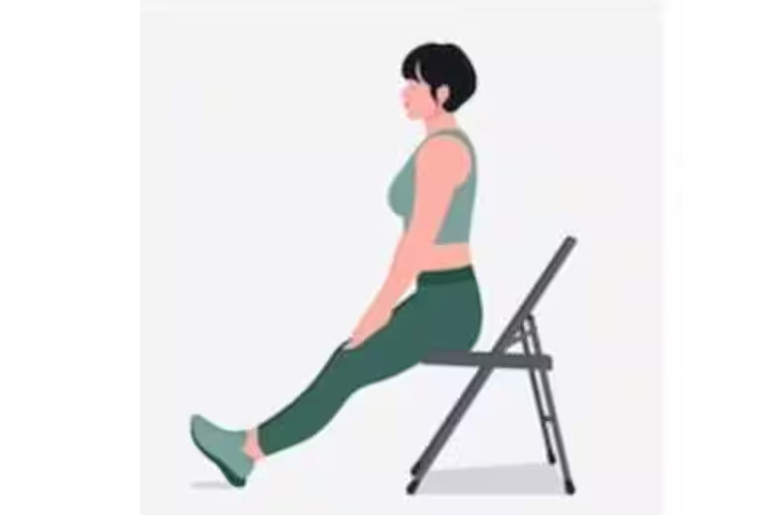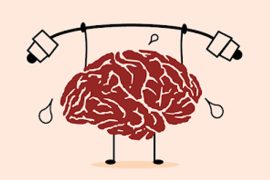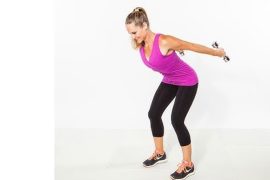Long hours of sitting at a desk can lead to weight gain, especially around the belly. While using standing desks and taking regular breaks help boost activity, you can also perform simple exercises right at your desk to burn calories and reduce belly fat. These exercises, such as seated leg lifts, chair twists, or desk push-ups, can be easily integrated into your routine, promoting movement and helping counter the effects of prolonged sitting without disrupting your workflow.
1. Seated Bicycle Crunches
Seated Bicycle Crunches are an effective exercise to engage your core while seated. To perform this exercise, sit tall in your chair with your back straight and feet flat on the ground. Lift your feet off the floor, bending your knees at a 90-degree angle. Place your hands behind your head or cross your arms over your chest. As you engage your core, bring your right elbow towards your left knee while extending your right leg out. Alternate sides by bringing your left elbow toward your right knee while straightening your left leg. Aim for 10-15 repetitions on each side. This movement targets the rectus abdominis and obliques, helping to strengthen the core muscles while improving stability and coordination.
2. Seated Leg Lifts
Seated Leg Lifts are a simple yet effective exercise to strengthen the hip flexors, quadriceps, and core. To perform this exercise, sit up straight in your chair with your feet flat on the floor. Extend one leg straight out in front of you, keeping it parallel to the ground. Hold this position for a few seconds, focusing on engaging your core, then lower your leg back down without letting it touch the floor. After completing the desired repetitions on one leg (10-15 times), switch to the other leg. This exercise can be beneficial for enhancing leg strength and stability while also promoting better posture.
3. Tummy Twists
Tummy Twists are a great way to improve core strength and rotational flexibility. Start by sitting upright with your feet flat on the floor and your hands placed on your shoulders. Keeping your lower body stable, twist your torso to the right while engaging your core muscles. Hold the twist for a moment, then return to the center and twist to the left. Aim for 10-15 repetitions on each side. This exercise targets the obliques, helping to strengthen the muscles responsible for rotation while also promoting spinal flexibility.
4. Chair Marches
Chair Marches are an excellent cardiovascular exercise that can be done while seated. To perform this exercise, sit up straight in your chair with your feet flat on the ground. Begin by lifting one knee towards your chest, then lower it back down. Alternate legs as if you are marching in place. This can be done for 1-2 minutes, maintaining a steady pace. Chair Marches help increase your heart rate, engage the core, and promote circulation in the legs, making it a beneficial movement for overall fitness.
5. Seated Knee Tucks
Seated Knee Tucks are a core-strengthening exercise that targets the lower abdominal muscles. To execute this movement, sit on the edge of your chair, leaning slightly back for support. Pull your knees towards your chest while engaging your core muscles, then hold for a moment. Slowly extend your legs back out without letting them touch the floor. Repeat this movement for 10-15 repetitions. Seated Knee Tucks not only strengthen the core but also improve balance and coordination, making them an effective addition to your desk workout routine.
6. Oblique Stretch
The Oblique Stretch is a simple yet effective way to improve flexibility in the sides of your body. Start by sitting up straight in your chair with your feet flat on the ground. Raise your right arm overhead and lean to the left, feeling a stretch along your right side. Hold this stretch for a few seconds, then return to the center and repeat on the other side. Aim for 2-3 repetitions on each side. This stretch helps relieve tension in the obliques and promotes better overall mobility in the torso.
7. Seated Russian Twists
Seated Russian Twists are a dynamic exercise that targets the obliques and enhances core strength. Begin by sitting on the edge of your chair with your feet flat on the ground. Lean back slightly, keeping your back straight and your core engaged. Clasp your hands together and twist your torso to the right, then return to the center and twist to the left. Complete 10-15 repetitions on each side. This exercise not only engages the core muscles but also improves balance and stability, making it a valuable addition to any desk workout routine.
8. Core Bracing
Core Bracing is a fundamental exercise that promotes core stability and proper posture. To perform this exercise, sit up straight in your chair with your feet flat on the ground. Draw your belly button in towards your spine to engage your core muscles. Maintain this engaged position while breathing normally, holding for 15-30 seconds. Repeat several times throughout the day. Core bracing strengthens the deep abdominal muscles, helps prevent back pain, and encourages better posture, making it an essential practice for those who spend long hours sitting.
Bonus Tips for Burning Belly Fat
- Stay Hydrated: Drinking water helps maintain your metabolism and can curb hunger. Aim for at least 8 glasses of water a day.
- Maintain Good Posture: Sitting up straight not only helps with engagement of core muscles but also prevents discomfort and promotes better breathing.
- Incorporate Small Movements: Take breaks to stand, stretch, or walk around. Even small movements can help burn calories and reduce belly fat.
- Healthy Snacking: Opt for healthy snacks like fruits, nuts, or yogurt instead of processed snacks to support your weight loss efforts.
- Mindful Eating: Pay attention to portion sizes and avoid eating mindlessly while working. Take breaks to enjoy your meals.
- Get Enough Sleep: Aim for 7-9 hours of quality sleep each night, as poor sleep can lead to weight gain and increased belly fat.
- Manage Stress: High stress levels can lead to weight gain, particularly around the belly area. Practice stress management techniques like deep breathing, meditation, or yoga.
Incorporating these seated exercises into your daily routine can help combat the negative effects of prolonged sitting, enhance core strength, and promote overall fitness, all while maintaining your productivity at your desk.
Disclaimer:
The information contained in this article is for educational and informational purposes only and is not intended as a health advice. We would ask you to consult a qualified professional or medical expert to gain additional knowledge before you choose to consume any product or perform any exercise.







